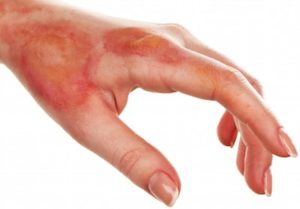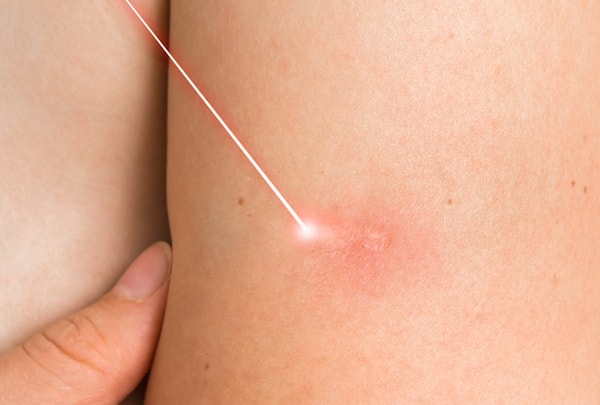Besides the pain that comes from getting a burn on the skin, patients can be at risk for a number of other complications including a risk of infection, damage to the nerves, a lack of mobility in the impacted area and a change of scarring or discoloration in the area where the burn is located. Thankfully, there are some opportunities for people that suffer a burn to lessen its impact on the skin and greatly reduce the chance of a scar resulting from the burn on the body. Let’s take a look at the different degrees of burns and also how to treat the burn during the healing process in order to lessen the appearance of a scar of any size that might appear on the skin.
Different Degrees of Burns
When people refer to the degree of a burn they have experienced, they are discussing the depth of the damage to the skin. Here are the various degrees of burns that patients can experience:
 First-Degree Burn – The burn only damages the epidermis of the skin (top layer of the skin) and causes skin discoloration that is pink to red. In addition, the skin will show some minimal swelling and patients will experience some moderate discomfort but the burn can normally be treated at home.
First-Degree Burn – The burn only damages the epidermis of the skin (top layer of the skin) and causes skin discoloration that is pink to red. In addition, the skin will show some minimal swelling and patients will experience some moderate discomfort but the burn can normally be treated at home.- Second-Degree Burn – This type of burn normally goes a bit deeper into the skin as it impacts both epidermis (top layer of skin) and dermis (bottom layer of the skin). In addition, a second-degree burn can cause blistering on the skin. Patients should place a clean bandage on the blisters that result from the burn. While patients can normally treat a second-degree burn at home, they are encouraged to seek professional medical attention if the burns are larger than the palm of their hand or if the burn involves the face, toes or fingers or if it goes across a joint. If the second-degree burn impacts any of these areas of the body, there is a higher risk for scarring that might limit the mobility of the impacted area.
- Third-Degree Burn – This type of burn damages the entire epidermis and dermis and is called a “full thickness burn’. The skin can look black, white or brown and the condition requires emergency medical attention.
- Fourth-Degree Burn – These burns cause the deepest damage to the body as they can reach the bones, muscles and tendons. Much like a third-degree burn, the skin can look black, white or brown and the condition requires emergency medical attention.
In addition to the burn degrees listed above, the two most common types of burns are chemical and thermal burns:
- Chemical burns are the result of exposure to acidic cleaning products such as bleach or hair relaxers and straightening formulas that contain lye, AKA sodium hydroxide, which can burn the scalp if there is prolonged exposure to the product on the scalp.
- Thermal burns occur when the skin comes into contact with heat that is so intense that the proteins that make up the skin cells start to break down. A thermal burn can also occur if exposure to a lower temperature takes places over an extended period of time (like a heating pad on the skin) or higher temperatures for a short amount of time (such a hot drink spilling on the skin).
The severity of either type of burn depends on the length of the contact as well as the temperature of the object causing the burn.
How to Treat a Burn Immediately after it Occurs
Immediately after a person experiences a burn, they should remove any clothing or jewelry near the burn but do not remove anything stuck to the burn.
If the burn is not serious enough to require immediate attention, the person should flush the burn with lukewarm water for 10-20 minutes to reduce the pain and slow the initial injury.
Do not flush a chemical burn with water if the chemical is known to react with water. Seek medical attention if the chemical burn is causing breathing difficulties or covering a large area of the body.
Do not pop any blisters that appear as they are helping the skin heal since there are white blood cells under the blister helping to get rid of bacteria that can cause an infection. Keep the skin clean and covered with a bandage or ointment until it is no longer oozing or open.
Treating Scars from Burns
The scars that can result from a burn can change the texture of the skin and make it darker or lighter in appearance. It can take years for the skin to regain its normal color and the discoloration can be a permanent change to the body.
Nanosecond and picosecond lasers can be used to stimulate the removal of hyperpigmented skin discoloration that comes from a burn injury and this is similar to the process of removing a tattoo with a laser.
In addition, pulsed dye lasers such as Vbeam, have proven to be effective in reducing the appearance of burn scars that are reddened in appearance.
For scars that are more complicated in nature than simple discoloration, CO2 ablative fractional lasers are ideal in treating scars that are hypertrophic (raised) or scars that have contracture. Low-density, fractionated, micro-ablative lasers have been shown to rehabilitate scars and improve the aesthetic appearance of the impacted area by giving the skin more flexibility and reducing the signs of burning.
Any of the above laser treatments normally require multiple treatments to achieve the best results and should be conducted by a board-certified doctor that is an expert in performing laser treatment of scars.
MA

